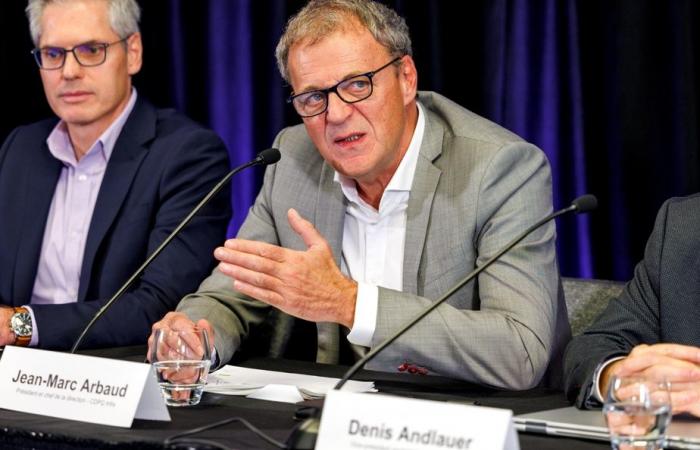The buses that will take over from the Réseau express métropolitain (REM) at several times starting this winter will be “capable of meeting demand,” promises CDPQ Infra, which affirms that the system will be more efficient than during unforeseen breakdowns.
Posted at 11:30 a.m.
“When you have a breakdown, it’s never predictable. There aren’t many buses that wait for a breakdown and can mobilize quickly. Here we are several months ahead. Everything will be planned, planned,” assured Thursday the vice-president of operations of CDPQ Infra, Denis Andlauer, at a press conference.
Earlier, Wednesday, The Press revealed that the north and west antennas of the Réseau express métropolitain (REM) should finally be delivered in the fall of 2025. Service interruptions are, however, to be expected to prepare for the migration of future control centers to the one that already exists, on the Rive -South.
From January, the REM will be closed on Saturdays from 11:30 p.m., then will reopen at noon on Sundays. Then, from February, it will be closed every weekend. Then, between April and June 2025, it will also have to be interrupted during the week from 9 p.m., in addition to closing every weekend, which will continue.
It will be in the summer of 2025 that this will hurt users the most, with a total closure of the network for four to six weeks.
Financially, the REM bill climbs by 392 million. An increase of one billion in expenses is attributable to the extension of work and the finalization of operations in the Mont-Royal tunnel, where approximately 85% of the operating systems have been installed to date. That said, the Caisse claims to have generated revenue from goodwill and financial capture of approximately 636 million.
In total, the REM project will therefore cost 8.34 billion, an increase of 4.9% compared to the most recent estimate of 8 billion. “If you look at comparable projects in North America over the last 10 or 15 years, it’s a remarkable achievement,” said President and CEO Jean-Marc Arbaud.
Every 10 minutes off peak
Outside peak hours, the relief bus service will operate every 10 minutes. “It’s more than enough to replace the REM. And at peak, we will have departures in all directions at the frequency needed to transport everyone,” said Mr. Andlauer, without giving further details.
Until then, meetings will take place with other carriers, exo, the Longueuil transport network, the Société de transport de Montréal and the Regional Metropolitan Transport Authority. “We are going to organize ourselves with our partners to have a suitable succession plan, capable of meeting demand,” said Mr. Andlauer.
This type of interruptions, “these are common security practices which are used on most networks in the world, when we are talking about an extension”, for his part justified the vice-president for the realization of the REM, Julien Hurel.
He gives the example of line 14 of the Paris metro, which was inaugurated last June. Before its opening, tests had caused several interruptions “on an even larger scale,” Mr. Hurel said.
At Trajectoire Québec, which defends the interests of users, we find the upcoming service interruptions “regrettable”. “That said, we understand that the next stages of the project will be complex and that there are no quick fixes. […] However, it remains imperative to minimize the impacts on users by ensuring that service interruptions last as short as possible,” responded the organization.






